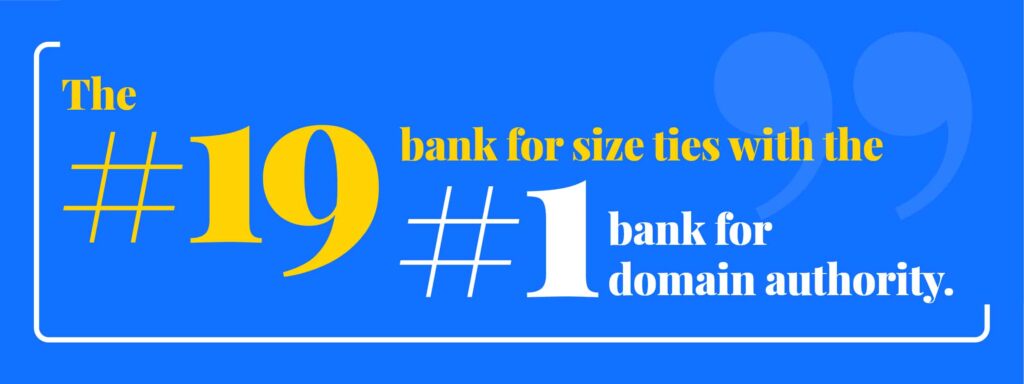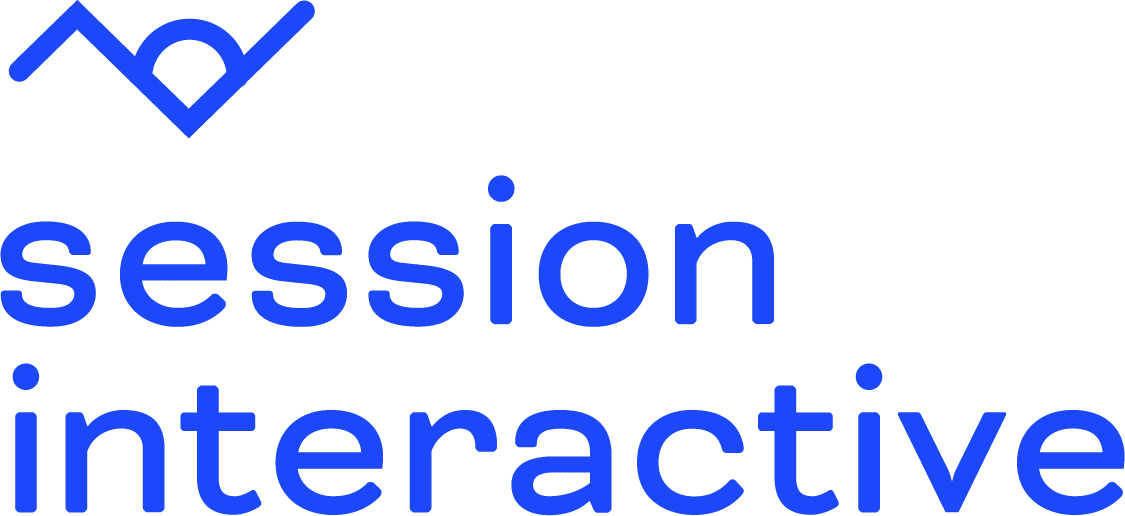Focus on the potential customer’s journey.
It sounds so simple but the implications are enormous.
Welcome to the Session Interactive guide to bank SEO strategy. We’ll explore the subtle art of speaking to your potential customers in the language they understand, when they want your services, and ultimately, converting them into current customers.
There’s huge opportunity here. The Financial Brand found that smaller banks were able to rival the top megabanks in domain authority – punching well above their weight in the market thanks to SEO investments.

How do banks stand out in search? Read on to find out.
In this guide:
We have worked closely with banks and credit unions to achieve their digital marketing goals. Our SEO management, technical SEO, and local SEO teams have years of experience generating leads for financial institutions like Umpqua Bank and Canvas Credit Union.
As a leading SEO agency for banks, we have tackled the challenges of generating high-quality organic traffic for banks and understand the needs of financial institutions.
SEO Strategy 101 for Banks
Banks are increasingly relying on marketing departments to prove their value in the business they bring in. Investing in an SEO strategy for banks is a great way to prove value over time. SEO takes time – you need to build up relevant content and authority in the digital space – but the reward is sustainable, inbound, organic growth.
What Is Bank SEO (Search Engine Optimization)?
Bank SEO, or Search Engine Optimization for banks, is the strategic process of improving your bank’s visibility on search engines like Google, Bing, and Yahoo. By implementing SEO strategies, banks aim to attract more organic (non-paid) traffic to their websites, which can lead to increased brand awareness, customer acquisition, and ultimately, financial growth.
What Is an SEO Strategy?
An SEO strategy is a comprehensive plan designed to increase a website’s visibility in search engine results, thereby attracting more organic traffic. It involves a series of coordinated actions aimed at enhancing the quality and quantity of website traffic through non-paid search results.
At its core, an SEO strategy is about understanding what potential customers are searching for online, the words they’re using, and the type of content they are looking for. Your strategy must use these insights to tailor your website’s content, structure, and on-page optimizations to meet the needs of searchers and search engines like Google. It should ladder up to your wider digital strategy for banks.
How to Build a Bank SEO Strategy
A robust bank SEO strategy optimizes your bank’s online presence to improve visibility and attract more potential customers. This guide outlines the essential steps to create an effective SEO strategy tailored for banks, focusing on research, goal-setting, planning, and execution.
1. Research
Research should underlie all digital decision-making. Banks should start by identifying their target audience’s search behaviors, preferences, and the keywords they use when looking for financial services. Look at search data to determine what is working in search for top results and how you can build on it. This step should culminate in a comprehensive list of targeted keywords and insights into effective strategies.
2. Goal-Setting
Set clear, measurable goals for your SEO campaign. These goals could range from increasing organic traffic, improving SERP rankings for specific keywords, enhancing local visibility, or boosting conversions through online applications for banking products. Make sure short-term goals are measurable progress towards long-term goals.
3. Planning
Develop a comprehensive SEO plan. This plan should detail the specific tactics to be employed, such as optimizing website content with targeted keywords, improving site structure and navigation for better user experience, and enhancing mobile responsiveness. Additionally, outline strategies for building high-quality backlinks, engaging in local SEO practices (like optimizing your Google My Business listing), and creating valuable, informative content that addresses your audience’s needs and queries. We’ll discuss these more below.
4. Execution
The execution phase is where your planning comes to life. Here are some of the steps you’ll want to include:
- Update your website’s content and structure based on the identified keywords and user experience improvements.
- Implement on-page SEO techniques like optimizing title tags, meta descriptions, and headers.
- Publish high-quality, relevant content regularly to attract and engage your audience while establishing your bank as a thought leader in the financial industry.
- Build links and monitor online reviews to enhance your bank’s online reputation.
- Monitor your progress using SEO tools and adjust your strategies to find the most effective approaches.
SEO Best Practices for Banks
SEO for banks requires a deep understanding of your potential customer’s journey from need to conversion. Because SEO deals with inbound traffic, your focus should be on what content they need to excite, inform, and convert purchases like checking and savings accounts or home and car loans.
Technical SEO
Technical SEO ensures that a bank’s website is well-structured and accessible to search engine crawlers, enhancing its visibility in search results.
- Ensure Proper Crawling of Your Website. Optimize site structure, using sitemaps, and ensure that all important pages are accessible. Be sure to check your robots.txt file, submit up-to-date sitemaps to search engines, and maintain internal linking.
- Identify and Fix Canonical Issues. Canonical tags help prevent duplicate content issues by specifying the “canonical” or preferred version of a web page. Banks should use these tags to avoid confusion between similar pages, such as different landing pages for the same type of account, ensuring that the search engine focuses on the intended page.
- Maintain Consistent Page Indexation. Keeping a consistent indexation ensures that all valuable content is searchable. Banks should regularly monitor their site’s index status to identify and rectify any pages that are mistakenly excluded from search results, like an essential service page that’s not being indexed.
Competitive Analysis
Understanding the competitive landscape is key for banks to differentiate themselves and capture market share.
- Investigate Competitor Strategies. Analyze what competitors are doing successfully in terms of SEO. This could involve examining their keyword usage, content strategy, or backlink profile. A bank might notice a competitor’s success with a particular set of keywords related to mortgage services and adjust its own strategy accordingly.
- Identify Backlink Growth. Assessing the quality and quantity of backlinks leading to competitors’ sites can offer insights into their authority and reputation. A bank could use this information to target similar high-quality backlink sources for its own site.
- Discover Keyword Gaps. Identifying keywords for which competitors rank well, but your bank does not, can uncover opportunities for content creation and optimization. For instance, if a competitor ranks highly for “best student checking accounts,” your bank may consider developing content around this theme.
Content Strategy
Content is at the heart of SEO, helping to attract, engage, and convert potential customers.
- Define Your Ideal Customer Profiles. Understanding who your customers are allows for more targeted and effective content. A bank might create profiles for different customer segments, such as college students, homeowners, or small business owners, to tailor content accordingly.
- Map Content Goals. Align content with specific objectives, whether it’s raising awareness about new banking products, educating customers on financial topics, or driving applications for loans. Each piece of content should have a clear purpose aligned with broader business goals.
- Resolve Audience Pain Points. Create content that addresses common questions or challenges faced by your customers. For example, a bank might produce a series of articles on navigating mortgage applications, offering practical advice that positions the bank as a helpful resource.
Local SEO
For banks, local SEO is crucial for attracting customers within their community.
- Create Exceptional Service Pages. Develop detailed pages for each service offered, incorporating local keywords. A bank might have individual pages for each branch, highlighting local services and community involvement.
- Monitor Local Keyword Rankings. Keep track of how your bank ranks for local search terms to gauge performance and identify areas for improvement. This could involve tracking rankings for terms like “banks near me” or “home loans in [City Name].”
- Optimize Your Google Business Profile. A well-optimized Google Business Profile can significantly enhance local visibility. Banks should ensure their profile is complete, accurate, and updated with current information, such as hours, services, and photos of the branch.
SEO Tips & Ideas for Banks
Let’s get right down to the nitty gritty: how to put these seo strategies into action. Here are tips and ideas that address the unique challenges of search optimization for banks.
1. Invest in Long-Term SEO Strategies
SEO is a marathon, not a sprint. Its effects typically begin to show within 3-6 months, but the full impact may not be evident for even longer. This slow burn is due to the time it takes to produce high quality content; for search engines to crawl, index, and rank new content; and the gradual accumulation of backlinks and domain authority. Patience is key. Banks investing in long-term SEO strategies can expect sustainable growth, improved search visibility, and a stronger online presence over time. The enduring benefits include increased organic traffic, higher conversion rates, and ultimately, more customers.
Keep in mind that an experienced partner can help reduce lag time in all areas of SEO, by performing expert research, identifying the most lucrative opportunities, and overcoming common issues with production schedules. We at Session Interactive have achieved results for six financial institutions including Canvas Credit Union, Cerity Partners, and Community Financial.
2. Increase Visibility with Local Citations
Local citations, which are mentions of your bank’s name, address, and phone number on other websites, play a crucial role in boosting search visibility. They help build legitimacy and authority by validating your bank’s presence in a specific geographical area. Search engines use these citations to gather information about businesses, influencing local search rankings. For banks, accumulating accurate and consistent local citations across reputable directories and platforms can enhance local SEO efforts, making it easier for potential customers to discover their services.
3. Focus on Location Service Pages
Developing geo-targeted service pages can significantly benefit banks looking to attract customers within specific regions or communities. These pages should cater to the unique needs and interests of local audiences, incorporating region-specific keywords and information. By doing so, banks can improve their visibility in local search results, providing a pathway for potential customers to find relevant services near them. Moreover, location-specific pages can offer personalized experiences, fostering a sense of connection and trust with the local community.
See how developing content for local branch pages drove organic traffic for Canvas Credit Union.
4. Create Content for Your Ideal Customers
Understanding and addressing the specific needs of your target audience is key to creating effective content. Banks must meet customers where they are and craft resources that guide them through major life stages, offering solutions tailored to those moments. These life stages often correspond with critical financial needs, creating natural opportunities for engagement.
For students, this could mean creating content that demystifies the process of opening a student account, managing finances for the first time, and understanding the basics of credit. Imagine clear, actionable guides titled “How to Open Your First Bank Account” or “Smart Budgeting Tips for College Students.”
For young professionals building credit, you could share insights about responsible credit card usage, understanding credit scores, or how to secure a personal loan. For example, a blog post like “The Beginner’s Guide to Building Strong Credit” could resonate with this audience, positioning your bank as a trusted partner in their financial growth.
First-time homebuyers have a unique set of needs and challenges. Content explaining the mortgage process, loan options, or a checklist for purchasing a home can be highly effective. Titles like “Steps to Buying Your First Home” or “Understanding Mortgage Options for First-Time Buyers” can address their concerns while boosting your SEO.
For those planning retirement, focus on creating resources like “How to Start Saving for Retirement in Your 30s,” “Understanding Your 401(k) Options,” or “Retirement Planning 101.” These pieces can provide clarity around a life stage that’s often daunting, helping customers feel better equipped and more confident in your bank’s expertise.
Research by sagapixel found that top-performing bank pages have content that “aligns with a question or financial problem that someone has and that a financial institution can help with.” Targeting moments in the buyer’s journey helps connect with your audience when they need you: when they’re researching financial products like yours.
Whether it’s through informative blog posts, helpful guides, or engaging videos, content that speaks directly to your audience’s concerns can drive engagement, build trust, and convert highly qualified traffic.
5. Investigate Competitors to Identify New Opportunities
Conducting a SWOT analysis (Strengths, Weaknesses, Opportunities, Threats) on your competitors can uncover valuable insights for your own SEO strategy. By understanding what your competitors are doing well and where they’re falling short, you can identify gaps in the market and areas for improvement. This analysis can reveal new keyword opportunities, content ideas, and strategies for gaining a competitive edge, helping your bank stand out in a crowded marketplace.
6. Monitor Keyword Performance
Tracking organic and local keyword rankings is essential for understanding your SEO performance. Organic rankings reflect how your website performs in search results nationwide, while local rankings focus on search results within specific geographical areas. Monitoring these rankings can provide insights into how well your SEO efforts are paying off and where adjustments may be needed. Banks need to track local rankings to ensure they’re reaching potential customers in their target regions.
7. Identify Backlink Opportunities
Backlinks from reputable websites can significantly boost your bank’s search engine rankings and online authority. Identifying opportunities for acquiring high-quality backlinks involves analyzing where your competitors are getting their links from and targeting similar sources. Guest blogging, partnerships, and creating share-worthy content are all effective strategies for building a robust backlink profile. Prioritizing these opportunities can enhance your SEO efforts and improve your bank’s visibility online.
8. Improve the User Experience on Your Website
Not only does great UX tend to result in higher rankings, it improves conversions from the traffic you already get. For banks, this means creating a website that’s not only informative but also easy to navigate and use. Factors such as fast loading times, mobile responsiveness, and intuitive navigation are critical. By prioritizing the user experience, banks can reduce bounce rates, encourage longer visit durations, and ultimately, convert more visitors into customers.
9. Leverage Paid Advertising and Social Media Insights
SEO is most effective when integrated into a broader digital marketing strategy, including paid advertising and social media. Pay-per-click (PPC) campaigns can complement SEO efforts by targeting competitive keywords, such as “bank near me,” offering immediate visibility. Beyond driving traffic, PPC campaigns provide valuable insights into high-performing keywords that generate actual conversions.
This data can be a goldmine for refining your SEO and content strategies. By analyzing which keywords have the highest click-through and conversion rates in your PPC campaigns, you can prioritize these terms in your organic content creation and optimization efforts. For example, if “best savings account for high school students” drives consistent conversions in PPC, it can inform blog topics, service page updates, or landing page content for long-term organic traffic gains.
Meanwhile, social media platforms can distribute content that may not be inherently SEO-friendly but still engages audiences and drives traffic. Paid and organic efforts should work together, with PPC campaigns identifying opportunities that shape SEO strategies, ensuring a cohesive and informed approach that guides consumers seamlessly from discovery to conversion.
10. Combine SEO Strategies with CRO
Pairing SEO with Conversion Rate Optimization (CRO) ensures that the traffic you attract translates into meaningful actions, like account sign-ups or loan applications. While SEO drives visitors to your site through targeted keywords and quality content, CRO focuses on optimizing the user experience to turn those visitors into customers. For example, enhancing your landing pages with clear calls-to-action and intuitive navigation boosts performance metrics like form completions and click-through rates. Together, these strategies create a seamless framework that not only increases traffic but also maximizes its value. Learn more about how to integrate these tactics effectively in our SEO-CRO strategy guide.
11. Demonstrate Your Experience, Expertise, Authoritativeness, and Trustworthiness
When it comes to banking content, EEAT (Experience, Expertise, Authoritativeness, and Trustworthiness) plays a critical role in building customer confidence, especially for Your Money or Your Life (YMYL) topics where the stakes are high. Ensuring your content is authored or reviewed by certified financial professionals anchors its credibility. Citing authoritative sources like government agencies, academic institutions, or well-respected financial organizations reinforces its reliability.
Additionally, linking to relevant regulatory disclosures, such as FDIC coverage details or loan terms, provides transparency and reassures readers that your bank adheres to industry standards. These efforts not only enhance your content’s integrity in the eyes of customers but also align with search engine algorithms designed to prioritize trustworthy information.
12. Utilizing Structured Data for Financial Products
Implementing structured data, such as schema markup, for financial products can significantly enhance how your bank’s offerings appear in search engine results. For products like loans, credit cards, and savings or checking accounts, schema helps search engines understand critical details, such as interest rates, terms, features, or customer ratings. This improved understanding enables search engines to display your offerings as rich results, like star ratings or interest rate summaries, directly in the search listings. These enriched snippets not only boost your visibility but also increase click-through rates by providing potential customers with key information at a glance, setting your bank apart in a competitive digital landscape.
13. Publishing Content That Features First-Party Data
Using first-party data allows your bank to create highly valuable and unique content that builds credibility and resonates with your audience. Insights drawn from internal data, such as customer trends, popular product features, or localized service statistics, can highlight your expertise and showcase the impact of your offerings. For instance, publishing a study on how your loan products have helped first-time homebuyers can provide compelling proof points while also establishing authority in the financial sector. This type of content differentiates your bank and reinforces trust by demonstrating a deep understanding of your customers’ needs and successes.
Ready to Rise in the Bank Rankings?
As you work through this guide, it will become clear that many of these strategies are easier said than done. Gathering insights, optimizing pages, planning your site and producing content are each specialties with their own expertise. You can significantly reduce the time it takes to see results from your SEO efforts if you rely on the experience of experts in the craft.
Introducing Session Interactive
At Session Interactive, we specialize in data-driven strategy. Our experts guide your team through proper data collection practices to provide a solid foundation. At every step, you and your team can see the results of each initiative in real-time and we communicate our findings and adjustments.
We’ve worked with banks and other financial institutions, so we’ve seen many of the hurdles you are likely to encounter. Here’s an in-depth example of how local search optimization and good on-page practice drove a 37% traffic growth for Canvas Credit Union.
Climb search rankings and win inbound conversions. Reach out to Session Interactive now for a personalized SEO strategy that drives results.





